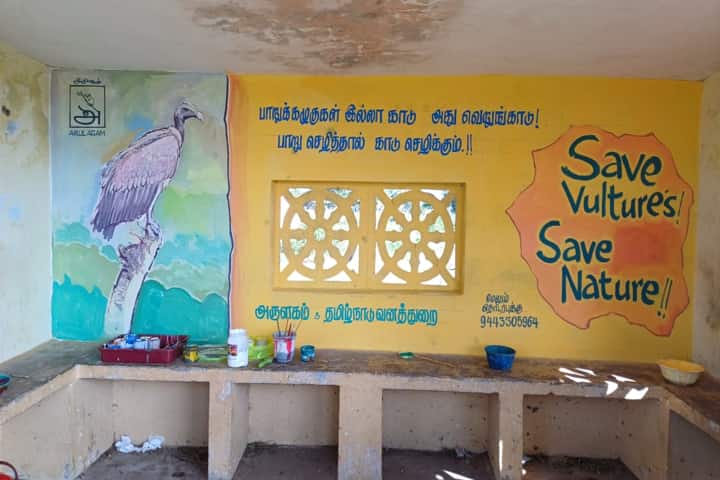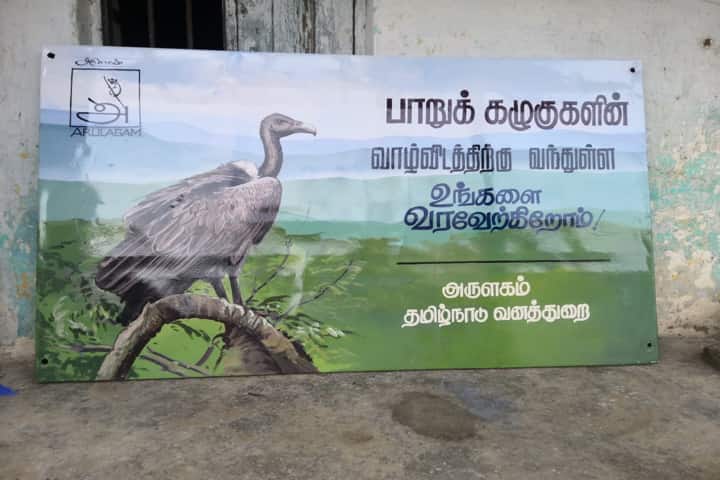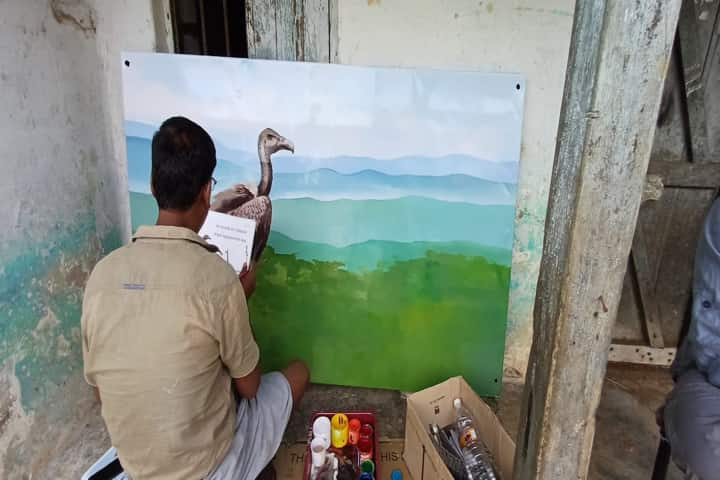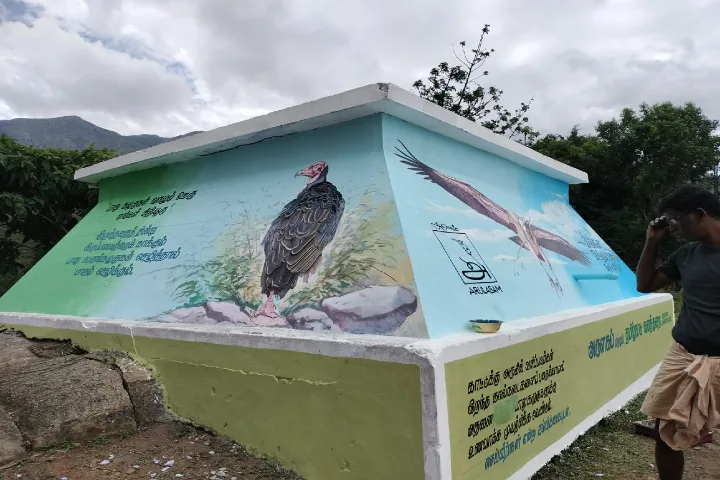Much ignored by people and authorities, the dwindling population of vultures, one of the most useful creatures as it scavenges and cleans the environment of carcasses, is worrisome. Arulagam, a Coimbatore-based non-profit organisation in Tamil Nadu has been working tirelessly for conservation of vultures as a number of their species have been categorised as endangered in India.
Founded in 2002, Arulagam recently launched a novel initiative bringing art to further the cause of vulture preservation. “We have initiated painting of murals in 12 villages in Mudumalai Tiger Reserve and eight villages in Sathyamangalam Tiger Reserve in Erode district in the first phase to raise awareness about the importance of vultures,” S. Bharathidasan, Secretary and Co-Founder of Arulagam informed India Narrative.

For this, noted artist R. Sivakumar, from Thiruvannamalai, has joined hands with Arulagam. He has drawn more than 250 birds in a realistic manner in a book titled Thiruvannamalai Mavatta Paravaikal which includes details of each of the birds.
When asked by IN why they chose painting for their cause, the Secretary replied: “Art is a powerful tool for conservation. It can be used to educate people about environmental issues and to inspire them to take action. It is a very easy medium to communicate. When art is done or kept in public places it immediately grabs attention and has a long and lasting impact.”
Elaborating on this for India Narrative he added: “This form of messaging gets local people involved. We seek their permission and their support. Also, when the art work is being done, it attracts people, especially children, who are curious to know what is happening. Our volunteers use this opportunity to tell them about vultures, their importance in the ecosystem, what they can do to help in its conservation and also distribute literature, pamphlets and booklets on the subject. The interaction is spontaneous, instant, warm and effective. Students and children are provided sheets with drawings on the subject to colour, which we tell them to paste on the walls.”

Incidentally, the organisation has used this method seven years ago when a volunteer did wall paintings for propagating conservation of vultures.
The reason for Arulagam to choose villages around MTR and STR to start their initiative is because in these areas the vulnerable and endangered vultures have been spotted. “The white backed vulture nesting site was found just 2.5 km close to the Moyar village where the drawing works have been completed. Similar works have been done at Siriyur village and will be taken up at Ebbanad where Long Billed Vulture nesting sites have been found nearby,” revealed Bharathidasan to IN. The third species painted in the first phase includes the Red headed vulture.
The issues touched upon by these murals are varied. Sharing some of them with India Narrative, Bharathidasan said: “Some people perceive vultures as dirty and feasting on the dead. That needs to be changed as they are very useful to humankind, taking care of the carcasses around. Once we drive this point home, people look at them as friends. We also highlight that, unlike other creatures, there is no conflict between humans and vultures. Stressing their endangered status, we request villagers and locals to inform the forest department officials or us about injured, abandoned chicks or those who have fallen from nests. Requests have also been put to people to inform forest department staff or us about carcasses. This is to enable the vets to make sure that the dead animal does not have harmful drugs and medicines in its body which are lethal for vultures when they eat them. Besides, we have conveyed to villagers that in case they lose their cattle due to attack by tigers, leopards or wild dogs, they may get in touch with us to help them get compensation. We have also appealed to doctors not to prescribe drugs to cattle that are harmful to vultures and also pharmacists to avoid selling such medicines.”
A total of nine paintings have been made in Siriyur and Moyar. “We chose public places which are frequented by people and where the public congregates in large numbers. These include bus stands, school buildings, and houses which are located on the main roads. For each place we sought permission of the authorities and owners of the building,” the Secretary said.
Most of the people were agreeable to have their walls painted. “There was an exception but he too agreed when he came to know that his neighbour’s wall had a mural painted by us,” Bharathidasan informed.

Once all the villages and areas in the vulture range in Tamil Nadu are covered, Arulagam plans to go to Kerala and Karnataka to continue this work where also vultures are found.
Telling India Narrative about other modes used by the organisation to drive home their message, Bharathidasan said: “It is a continuous process and we communicate through rallies, puppet shows, street plays, presentations, and organizing exposure visits to the stakeholders especially pharmacists and veterinary doctors to the vulture home areas.”
Also read: Conservationist S. Bharathidasan takes lead to save endangered vultures in Tamil Nadu




















